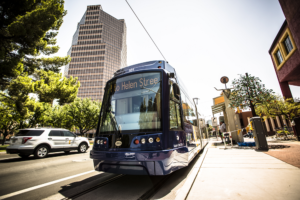
Although no one is quite ready yet to predict whether it will reach its ultimate destination, Tempe’s proposed streetcar initiative seems finally to be headed down the track to reality.
A pair of significant new developments occurred during the first week of February, causing local transportation planners to say they’re increasingly optimistic that $75 million in federal funding will be available to help offset the project’s $177 million in anticipated costs.
Depending on Congress’ approval of President Barack Obama’s just-submitted budget, construction could begin as early as next year, resulting in the project being ready to welcome its first riders within three years or less.
Earlier this month, U.S. Transportation Secretary Anthony Foxx outlined among his agency’s budget-item proposals a $3.5 billion allocation for fiscal 2017 that would advance the construction or completion of 31 rail, bus rapid-transit and streetcar projects in 18 states.
Included among those was funding requested by Tempe, designed to supplement amounts that would be competitively overseen by the Federal Transit Administration’s Capital Investment Grant Program.
Nationwide, said Foxx, his agency’s recommended budget, if approved, would create thousands of construction and operations-related jobs and help communities expand transportation choices that offer new ladders of opportunity for residents.
Locally, officials say the addition of streetcar transit will help relieve traffic congestion, especially as more apartment/condominium construction occurs and as many as 9,000 employees take jobs awaiting them in the massive State Farm complex bordering Tempe Town Lake.
Although, as noted earlier, there remain no assurances that the Obama budget proposal will be funded in its entirety, sources said Tempe’s inclusion among recommended projects carries with it a huge amount of inherent promise.
“Once a project is on the list, there is no history of it ever having not been funded,” said a local source who asked not to be named because of lacking the authorization to speak on the matter.
In addition to Tempe, cities requesting Small Starts projects and appearing on the latest FTA budget-proposal list include Sacramento, Fort Lauderdale, Jacksonville, Indianapolis, Grand Rapids, Kansas City (Mo.) and Albuquerque, as well as Everett and Seattle, Wash.
Don Cassano, a onetime Tempe vice mayor and longstanding advocate for improving transit opportunities in the city, called the FTA announcement a major cause for optimism.
A veteran member of the city’s Transportation Commission and its current chair, Cassano said other recent developments add even greater promise to the project being funded.
“The FTA told us in January we could begin to move ahead; they wouldn’t have let us go that way if they felt it would fall on its face.”
Was that reasonable justification for Tempe’s new positivity?
“This was a big leap,” Cassano said. “I don’t know where we would have gone with the project otherwise.”
As to other funding, approximately $70 million remains among the assets from taxpayer-approved Prop. 400, effectively providing Tempe with $19 million a year for a number of years, Cassano noted.
As to how the Tempe streetcar proposal was able to gain this latest burst of momentum, Cassano traced the history of what seems to have been a quiet but unrelenting campaign that Tempe has waged to get the project funded.
For example, the route that was proposed originally didn’t satisfy federal planners, so it had to be revisited, he said. “This was one piece of the puzzle. We had to go back and look at the route. Now it goes down Apache, which seems to have represented the turning point.”
Yet another change revolved around discussion among City Council members about taking the route as far south as the Tempe Public Library at Southern and Rural, a piece that now has been approved as part of the route’s future expansion, according to Tempe Public Information Officer Amanda Nelson.
Other questions remain, of course—among them the type of propulsion system that might be best suited for the project.
Offered Cassano: “Council said they wanted us to look at overhead wires—but no wires on Mill Avenue. Maybe battery power. But not during the summer, that is.”
With perhaps the greatest degree of confidence they have had so far, planners now know that they’ll have the challenge of exploring these unresolved issues as well as a number of other options and possibilities as the weeks and months unfold.


So let’s think about this for a minute. Between this and a dedicated bike lane, you will no longer be able to get a car through Mill avenue anymore. The little parking that’s there is, is expensive. Outside of a few remaining party bars for the college students there’s really no reason to even go into downtown Tempe anymore. Everything worth going to has long since moved over to Tempe Marketplace where you have lots and lots stores, family restaurants, and FREE parking. I was there yesterday, Saturday, and it was really crowded. They want to spend $177 million of our tax money to benefit a few surviving business owners? EVERYONE involved in this should be fired! Google this . . . “Meet the worst transit project in America”